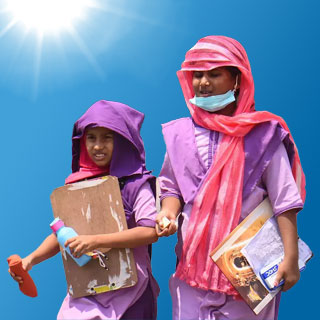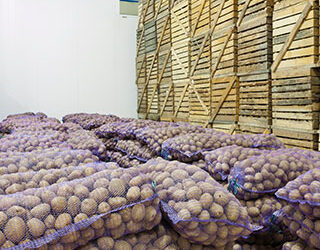SAHARA: Supporting Affordable Heat Action for Resilient Academic Institutions

Access to cooling for attaining thermal comfort is no longer a luxury but, rather, a necessity for enhancing the overall quality of life, productivity, and well-being.
India’s Heat Stress and Access to Cooling Scenario
India is one of the largest and fastest-growing economies in the world, with its average temperature being projected to rise by up to ~2.4°C1 by the end of the 21st century—which would result in extreme heat stress, with devastating impacts on human health and energy security. In addition, it has been estimated that an increase in surface temperature and humidity will further intensify the heat stress across India, particularly over the Indo-Gangetic and Indus river basins2. Regardless of the growing economy and pressing climatic need for cooling, according to the India Cooling Action Plan 2019, India has one of the lowest access to cooling, with a per capita space cooling energy consumption at 69 kilowatt-hours (kWh) compared to the world average of 272 kWh. Therefore, with around 4 trillion person cooling degree days per year3, coupled with a lack of access to cooling and thermal comfort, rising temperatures, rapid population growth, and urbanization will not only amplify heat stress but will also fuel the demand for space cooling.
In parallel, various national and international organizations, namely The Intergovernmental Panel on Climate Change, United Nations Children’s Fund, and National Research Development Corporation, have indicated that India’s rapidly changing climate will have a severe impact on the entire ecosystem, particularly children who are identified as one of the vulnerable groups and are adversely impacted by heat stress. Also, according to AEEE’s 2021 Decoding Evaporative Air Coolers report, there is a lack of discussion about thermal comfort or the need for space cooling technologies for academic institutions and evaporative air coolers’ potential application in these settings. The report suggested that i) efforts should be made to provide access to thermal comfort in settings used by children and ii) there is a need to undertake a technology assessment study to determine which type of evaporative air cooler (EAC) could be best suited for these settings for achieving thermal comfort. In comparison to a conventional room air conditioner, an EAC is 85% affordable, consumes 56% less energy, and is a Non-Global Warming Potential (GWP) refrigerant-based space cooling solution4.
Need for Thermal Comfort in India’s Academic Institutions
Go back and recall the days when you used to attend school during the hot and peak summer months of April to June—did you felt like studying or paying attention to the lectures given by your teachers in the classroom, which had only four to six conventional fans running amongst the occupancy of forty to fifty students and no other space cooling appliance available to reduce the heat stress? We all have experienced that situation, and somewhere we all knew that thermally uncomfortable learning spaces resulted in our reduced attention span and impacted our health and well-being, eventually impacting our exam scores.
As per the Unified District Information Systems for Education Plus (UDISE+) 2019-20 report by the Ministry of Education, India has more than 15,00,000 lakhs (1.5 million) schools, of which the 11,16,932 lakhs schools are managed by the government and 3,37,499 are managed by private entities.
However, none of the reports or policies focusing on India’s education sector encompasses thermal comfort as one of the key priorities for the school infrastructure, as shown in Figure 1. Thus, it can be said that thermal comfort in India’s academic sector has never been prioritized, while it can provide multiple benefits. Moreover, India’s policy and regulatory framework do not bestow information on the associated benefits of providing access to thermal comfort for children in academic institutions; this area has been least focused on. Therefore, India faces the challenge of providing access to thermal comfort for children in India’s academic institutions.
 Source: India Ministry of Education, “Unified District Information Systems for Education Plus (UDISE+) 2019-20,” 2019, https://www.education.gov.in/sites/upload_files/mhrd/files/statistics-new/udise_201920.pdf
Source: India Ministry of Education, “Unified District Information Systems for Education Plus (UDISE+) 2019-20,” 2019, https://www.education.gov.in/sites/upload_files/mhrd/files/statistics-new/udise_201920.pdf
Achieving thermal comfort in the academic sector can bring about systemic changes on multiple fronts ranging from increased attendance to enhanced quality of education and improved quality of life. Furthermore, bringing the students closer to using EAC, a Non-GWP refrigerant-based space cooling solution to achieve thermal comfort in the constantly warming world, can lead to wider adoption of energy-efficient space cooling appliances—leading to Thermal Comfort for a Billion Lives (TCBL).
AEEE’s Intervention: Institutionalising Thermal Comfort in India’s Academic Institutions
Alliance for an Energy Efficient Economy (AEEE), in partnership with Symphony Ltd., initiated the first-of-its-kind pilot “SAHARA programme”, a programme for Supporting Affordable Heat Action for Resilient Academic Institutions in India. The programme aims to mainstream super-energy efficient, affordable and sustainable space cooling solutions in India’s academic Institutions to bring in systemic changes and ensure Thermal Comfort for a Billion Lives (TCBL) by i) assessing the heat stress scenario, ii) identifying the ideal space cooling solution and iii) deploying the select solution for institutionalizing thermal comfort in India’s academic institutions. The programme will also draw support from AEEE’s ongoing project SHEETAL.
The SAHARA programme would act as a catalyst for disseminating knowledge about the thermal comfort situation in India’s academic institutions. It could bring about systemic changes on multiple fronts in the long term, ranging from enhanced thermal comfort conditions for students in academic institutions, the improved willingness of students to attend school, and improved educational outcomes. It is also envisioned to contribute toward the Sustainable Development Goals (SDGs)—3:Good health and well-being, 4:Quality education, 11:Sustainable cities and communities and 13:Climate action.
Read more about the project here.
Stay tuned for our next blog, which will present the key findings from the systematic review of standards and best practices adopted globally for providing access to thermal comfort in academic institutions!
This blog is written by Akhil Singhal, Srishti Sharma and Nikhil Sharma




